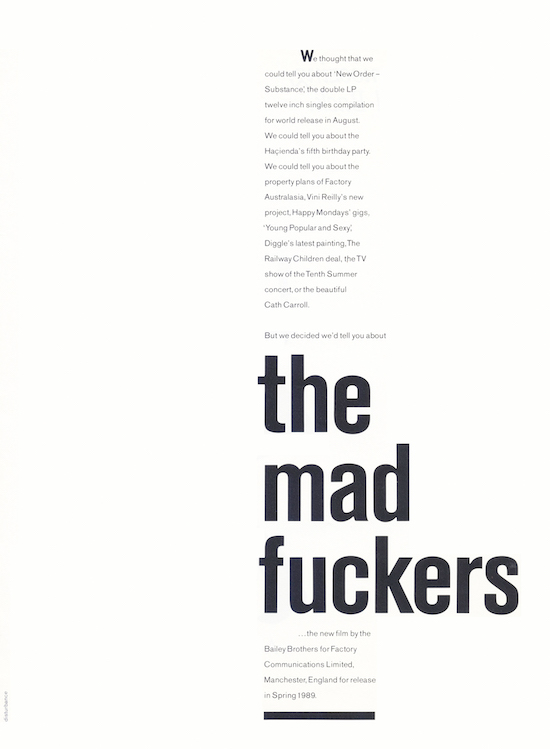Ever wondered where the term “MADCHESTER” came from? Would you believe me if I told you it arose out of a lost Factory Records film that nearly featured a Durutti Column-heavy soundtrack with Gabriel Byrne in the starring role? Well, it’s true. The piece of Factory celluloid arcana in question is The Mad Fuckers. Most sources say Tony Wilson coined the (in)famous city branding, but it actually started as a glorious cinematic mistake. Described as a “youth exploitation” film, The Mad Fuckers is one of the mythical Factory Records ideas that never really happened, like Linder Sterling’s Menstrual Egg-Timer (FAC 8) or Liz Naylor’s screenplay Too Young to Know, Too Wild to Care (FAC 20). It should be one of the legendary stories of the label, yet The Mad Fuckers remains a mystery to many, including the most ardent Factory aficionados.
While conducting interviews for my new book, I Thought I Heard You Speak: Women At Factory Records, I discovered that many people in the Factory universe remembered The Mad Fuckers even though the screenplay rarely gets mentioned in the label’s lore. I just had to do a deep dive, and I began to wonder: Could revisiting The Mad Fuckers offer a new lens into Factory Records on film, transatlantic histories of car-chase movies, and cinema censorship? Might excavated details about The Mad Fuckers reveal a fresh story of the movie soundtrack, especially when it comes to teen 80s movies that introduced audiences to New Order, Happy Mondays, Talking Heads, Nick Cave & The Bad Seeds, the Psychedelic Furs, the Smiths, Echo & the Bunnymen, and more?
“We got told by one of the legal representatives that we couldn’t call the city we were basing it in ‘Manchester,’” Keith Jobling of the Bailey Brothers remembers of The Mad Fuckers screenplay writing process. The advice from Factory’s lawyers was that they’d open themselves up to potential legal liability with a Manchester setting, with various characters based on real-life figures around the city. “We spent quite a lot of time smashed off our face writing around the clock because we were also working proper jobs while doing it,” Jobling says, and “we came up with the concept of ‘Madchester’… but it started as a typo! The more we started saying it, the more it felt right for what we were in the middle of. We went to Wilson and said, ‘we’ve got this idea, Madchester, but we don’t want anyone to know about it. We want to keep it a secret.’ Two weeks later, it’s on the front of Newsweek,” he laughs. “That’s about how bad Wilson was at keeping a secret!”
The story of…


